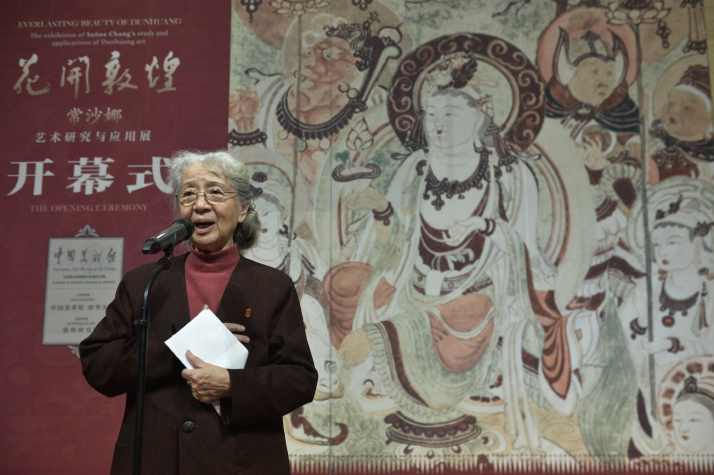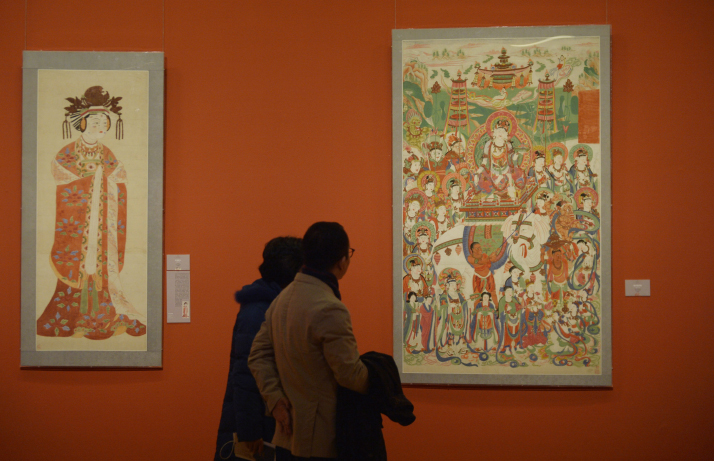| Lifestyle |
| The flying designology of Dunhuang | |
|
|
 Chang Shana addresses the opening ceremony of Everlasting Beauty of Dunhuang, the exhibition of her study and application of Dunhuang art, at the National Art Museum of China in Beijing on March 8, 2017 (XINHUA)
The Mogao Grottoes along the ancient Silk Road in Dunhuang, Gansu Province, are a historical gem accommodating 492 grottoes decorated with murals. Over 50,000 square meters of murals record the Buddhist art and customs of roughly one millennium, from the fifth to the 14th century. On May 1, the Magic Dunhuang Immersive Art Exhibition at Moganshan National Park in Deqing County of Zhejiang Province opened its doors to the public. There, divided into four zones, modern art integrates with the fairyland of the Dunhuang Caves, so that visitors can wholly immerse themselves in the beauty of the art. The exhibition displays works by father and daughter: Chinese painter Chang Shuhong (1904-94) and artist Chang Shana (born in March 1931). According to Huang Xuanzi, art director of the exhibition, this event promotes the diversification of cultural scenic spots in China. "How to push cultural aesthetics onto the market is a question facing all exhibitions of this type," Huang said. Finally, it was decided that the exhibition would take place at Moganshan National Park in Zhejiang. Spread the art The show displays traditional elements, with modern byproducts incorporating original Dunhuang elements to appeal to younger generations. "The caves are an inexhaustible cultural source for newfangled art, so we can expect to see more related art exhibitions pop up in the future," Huang said. "What matters most here is that we make full use of the Dunhuang essentials to spread the culture in a way that conveys its truest glamour," he added. Today, Dunhuang culture and art are eager to attract younger audiences. "And who knows, interactions between different generations may ignite new sparks," Huang said, adding he hopes more young admirers will eventually devote themselves to the research of this art and inject new vitality into the ancient discipline. In July 2014, the Today Art Museum in Beijing hosted the first Chang Shana research and application exhibition of Dunhuang design art, explaining the importance of the caves and their related art from the perspective of design. The Chang Shana Dunhuang pattern research studio was officially established under the Dunhuang Research Academy in May 2016, cataloging paintings, clothing and decorations appearing in the caves' frescos and creating new designs based on these elements. Whereas the academy itself focuses on the further exploration and protection of the caves, Chang Shana's studio is devoted to researching the Dunhuang decorations and spreading this traditional Chinese pattern art to audiences worldwide. According to Huang, when she was in her early 20s, Chang Shana was invited by Lin Huiyin, a famous architect specializing in classic Chinese architecture, to work as an assistant at the Architecture School of Tsinghua University. Huang believes it was exactly because of Lin's influence that she embarked on a career decorating in Dunhuang style. Throughout the 1950s, Chang Shana raked in several prestigious projects, participating in the design of the Great Hall of the People, painting the Beijing Exhibition Center, embellishing the Capital Theater, and so on. Despite a passion for innovation, she always tells her staff not to rush the work. "You must first grasp the meaning of a specific art or style before you start innovating; otherwise the innovation will be nonsense," Chang Shana has stated on multiple occasions. This September, an art gallery honoring father and daughter, as well as the Chang Shana Dunhuang pattern research studio, will come into being at Zhejiang Sci-Tech University, Chang Shuhong's alma mater.  Visitors look at Chang Shana's paintings at the exhibition of her study and application of Dunhuang art at the National Art Museum of China in Beijing on March 8, 2017 (XINHUA)
Dunhuangology From July to September 2019, Everlasting Beauty of Dunhuang: A Chang Shuhong and Chang Shana Art Exhibition was staged inside the Tsinghua University Art Museum. This second exhibition occurred exactly 73 years after the first joint exhibition displaying the father's and daughter's creations in 1946. The exhibition unfolded in storytelling fashion. While a student at the National School of Fine Arts in 1930s Paris, Chang Shuhong supposedly stopped at a secondhand book stall where he was invited to peruse a copy of French Sinologist Paul Pelliot's book documenting the Mogao Caves. The next day, or so as legend has it, he found out how a large collection of Asian artworks on display at the Guimet Museum had been stolen from various sites in Dunhuang by Western explorers. These findings instigated the painter's lifelong interest in the caves and would precipitate his decision to return to China, where he would become known as "the guardian of Dunhuang." Actively searching for scattered cultural relics, organizing exhibitions and publishing picture albums, Chang Shuhong did everything in his power to spread the word about this ancient treasure trove. Chang Shana swiftly followed in her father's footsteps and began copying the Dunhuang murals at the age of 13. From West to East, the caves have received their fair share of academic attention, but the two hemispheres focus on different things. Western studies are more about the Buddhist texts in books and scrolls found in the caves, whereas Chinese researchers center on the grottoes' decorative patterns. In recent years, Dunhuangology in the West has seen a shortage of young professional researchers. But related studies are still faring well in China thanks to generations of Dunhuang art guardians—like Chang Shuhong. The Dunhuang Research Academy has long been working with countries performing well in the field of Dunhuangology, particularly France. In May 2021, the academy and the Guimet Museum jointly hosted an online symposium, announcing the launch of a digital cave for Buddhist texts to explore tech-savvy ways of preserving Dunhuang culture. Chang Shana in turn hopes her studio can first scout some premium Chinese brands for the purpose of cooperation, then promote the cultural image of Chinese brands and eventually take traditional Chinese pattern art beyond national borders. With several Chinese jewelry and cosmetics brands already delving into the grottoes' history and creating experimental designs, it seems this ancient art is ready for a modern makeover. Copyedited by Elsbeth van Paridon Comments to dingying@cicgamericas.com |
|
||||||||||||||||||||||||||||
|